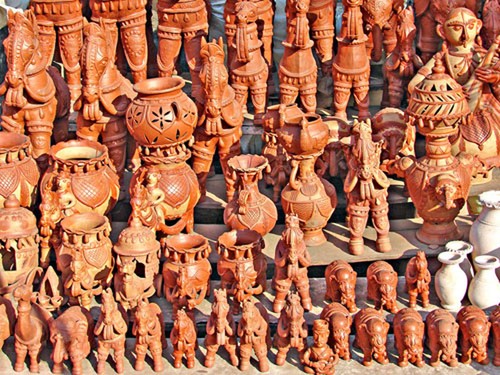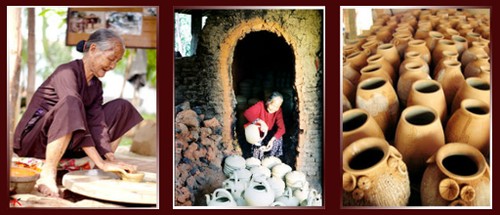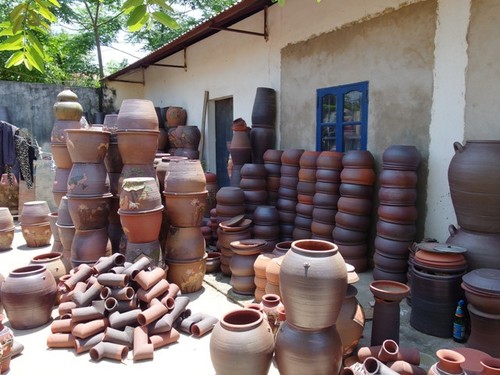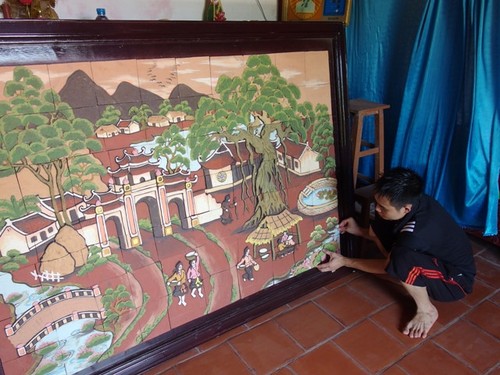A: We’d like to welcome back Allan R. Loudell of the US, who has not written to us for a long time. Mr. Loudell wrote that he is still listening to VOV via shortwave and submitted a report for a program on October 28 on 7315khz. SINPO rating was 45433.
 Ceramic products of Tho Ha village, Bac Giang province Ceramic products of Tho Ha village, Bac Giang province |
B: Thank you, Mr. Loudell, for writing to us after such a long time. We’ll confirm your report with a QSL card and hope to hear more from you.
A: After listening to our broadcast on the internet on November 7, Saleem Akhta Chadhar of Pakistan wrote: “Respected friends of Voice of Vietnam. Hope you are fine. I am also fine. From a previous Letter Box I learned some interesting information about Bau Truc pottery village in Ninh Thuan province. It is very famous for its attractive and charming work.which impressed me very much. I also heard the story about the zoo ," Thu Le Park" in Hanoi. This zoo is full of animals of many kinds. I also listened to the listeners’ letters and reception reports. Your programs are very informative. I gain much information about world news as well as cultural facts about Vietnam. Thank you very much.”
B: Thank you, Mr. Chadhar, for tuning in to VOV. In Vietnam, there are many pottery villages around the country that still practice their traditional craft. Thanh Ha village, 3 km from Hoi An in Quang Nam province has been producing pottery since the 15th century and today contributes to the charm of Hoi An as a tourist destination.
 Thanh Ha pottery Thanh Ha pottery |
A: Thanh Ha pottery village visitors are impressed by the village’s brick-paved roads and houses roofed with tiles made by local potters. Shops huddled close together display all kinds of Thanh Ha pottery from fine art pieces to items meant for daily use. The village is always crowded with visitors.
B: In Thanh Ha village potters use a brown clay of high viscidity and adhesion taken from the Thu Bon River. The clay is kneaded until it is as soft and smooth as cake flour. The special techniques that are used to process, shape, and polish the clay make Thanh Ha pottery products extremely durable and shiny. And Thanh Ha pottery is notably lighter than other pottery.
A: Thanh Ha potters are still using traditional methods. They use their foot to spin the potter’s wheel when shaping a lump of clay. Most Thanh Ha villagers know how to make pottery but it takes many years to become a master.
B: After being shaped, the product is dried in direct sunlight before undergoing the firing process. Depending on the product, firing can take 1 to 3 days. As they shape the clay and polish the final product, the potters inject their soul into their work.
 Phu Lang ceramics Phu Lang ceramics |
A: Phu Lang ceramic village, 60 km from Hanoi, in Que Vo district, Bac Ninh province, is one of the oldest pottery centers of the Red River Delta. The village is best known for its unique pottery products made with traditional techniques.
B: The village retains the simple beauty and peaceful atmosphere of yesteryear with its narrow zigzag lanes, red brick walls, and unchanging scenes of rural Vietnam. Jars and vases line the streets of the village because almost every family in the village makes pottery. It was at the beginning of the Tran dynasty in the 13th century that pottery first appeared in Phu Lang.
A: While Tho Ha ceramic is made of green clay, and Bat Trang ceramic is of white clay, Phu Lang ceramic is made of red clay. Phu Lang pottery products are quite varied, ranging from intricately carved devotional items like Buddha statues and urns, to simple household utensils like jars and vases. Decorative patterns on the ceramic products are also varied featuring the landscapes and daily activities of rural Vietnam. All the work is still done manually. To glaze the products, local artisans use home-made glaze and carefully control the heat of the wood fire.
 Phu Lang is famous for making ceramic paintings Phu Lang is famous for making ceramic paintings |
B: The firing process plays an important role in making pottery in Phu Lang. The local people still use a wood fire to fire their ceramics and it is changes in the temperature of the furnace that gives Phu Lang pottery its special colors: brown, yellowish or dark brown. Phu Lang ceramics are special and renowned for the diversity and quality of their enamels. Indeed, the shapes of Phu Lang pottery are raw and rough.
A: The furnaces in Phu Lang are different from those in other villages. For example, Dong Trieu ceramics in Quang Ninh province require higher temperatures, Bat Trang ceramics are earthenware ceramics fired with gas. The furnaces in Phu Lang are controlled by the craftsmen themselves and not everyone can do it.
B: Today, Phu Lang ceramics are famous throughout Vietnam and overseas. Ceramics are exported in large quantities to the Japanese, Canadian, Italian and South Korean markets. Growing sales have improved the living standards of the villagers.
A: Here’s an email from Jayanta Chakrabarty of India, who liked our story about soil erosion in coastal areas and Vietnam’s efforts to solve the problem which was broadcast from 16:00 to 16:30 UTC on November 7 on the frequency of 7220.
B: Jalangir Alam of Bangladesh wrote: “For me, your station is a good friend and the best teacher. I always find it a lot of fun to learn with your station and my life has become a lot more interesting because of your station.”
A: Thank you, Mr. Alam, for your feedback. The goal of the VOV World Service main motto of VOV is to link Vietnam with international friends. We want to help people in the rest of the world better understand Vietnam, its land and people.
B: Martin Steiner of Australia listened to our program on November 10 from 10:00 to 10:27 UTC on the frequency of 12020 khz and wrote: “I live in western Australia and enjoy listening to shortwave radio. Today I listened to your program again as I love hearing what is going on in Vietnam. I visited Vietnam few months ago and really enjoyed it. I love the country and its friendly people.”
A: Thank you, Mr. Steiner, for tuning in to our program again. We’ll confirm your report with a QSL card and hope to receive more feedback from you.
B: We’d like to acknowledge emails and letters SB. Sharma and Muhammad Shamim of India and Hayato Furukawa of Japan.
A: Thank you all for tuning in to VOV. We welcome your feedback at: English Service, VOVWORLD, Voice of Vietnam, 45 Ba Trieu Street, Hanoi, Vietnam. Or you can email us at: englishsection@vov.org.vn. You’re invited to visit us online at vovworld.vn, where you can hear both live and recorded programs. Check out our VOV Media App available on both the IOS and Android platform to hear our live broadcasts. We look forward to your feedback on the mobile version of vovworld.vn. Once again, thank you all for listening. Goodbye until next time.